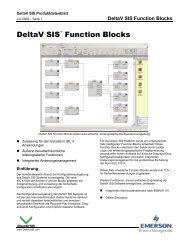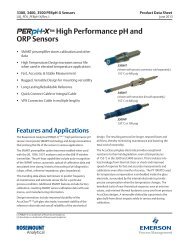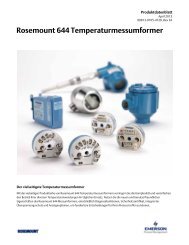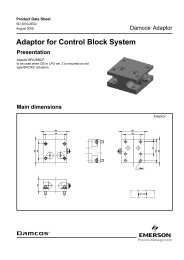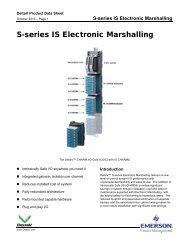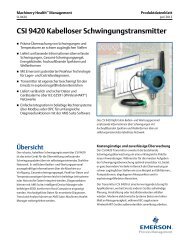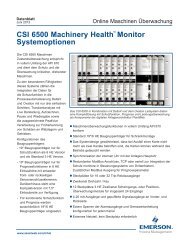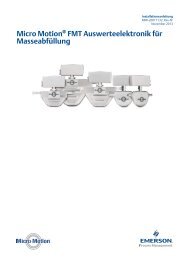Rosemount 3051S Electronic Remote Sensors - Emerson Process ...
Rosemount 3051S Electronic Remote Sensors - Emerson Process ...
Rosemount 3051S Electronic Remote Sensors - Emerson Process ...
Create successful ePaper yourself
Turn your PDF publications into a flip-book with our unique Google optimized e-Paper software.
<strong>Rosemount</strong> <strong>3051S</strong> ERS System<br />
2-14<br />
Reference Manual<br />
00809-0100-4804, Rev AA<br />
January 2011<br />
ERS System with Optional <strong>Remote</strong> Display and Interface (Figure 2-10<br />
and Figure 2-11)<br />
1. Remove the housing cover labeled “Field Terminals” on both ERS<br />
sensors and the remote housing.<br />
2. Using the ERS Madison Cable (if ordered) or an equivalent 4-wire<br />
shielded assembly per the specifications detailed on page 2-14,<br />
connect the 1, 2, A, and B terminals between the two sensors and<br />
remote housing in a “tree” (Figure 2-10) or daisy-chain (Figure 2-11)<br />
configuration.<br />
3. Connect the ERS system to the control loop by wiring the “+” and “–”<br />
PWR / COMM terminals of the remote housing to the positive and<br />
negative leads, respectively.<br />
4. Plug and seal all unused conduit connections.<br />
5. If applicable, install wiring with a drip loop. Arrange the drip loops so<br />
that the bottom is lower than the conduit connections and the<br />
transmitter housings.<br />
6. Reinstall and tighten all housing covers so that metal contacts metal<br />
to meet explosion-proof requirements.<br />
NOTE:<br />
I.S. barriers with inductive loads greater than 1 mH should not be used with<br />
the <strong>3051S</strong> ERS System and may cause the device to not function properly.<br />
ERS Cable Specifications<br />
• Cable Type: Recommend Madison 04ZZXLF015 cable. Other<br />
comparable cable may be used as long as it has independent dual<br />
twisted shielded pair wires with an outer shield. The Power wires (pin<br />
terminals 1 & 2) must be 22 AWG minimum and the communication<br />
wires (pin terminals A & B) must be 24 AWG minimum.<br />
• Maximum Cable Length: Up to 100 feet (30,5 meters), depending on<br />
cable capacitance<br />
• Cable Capacitance: The capacitance between the communication<br />
lines as wired must be less than 5000 picofarads total. This allows up<br />
to 50 picofarads per foot (163 picofarads / meter) for a 100 ft. cable.<br />
• Cable Outside Diameter: 0.270 in. (6.86 mm).<br />
4-20 mA Loop Wiring Specifications<br />
It is recommended to use twisted pair wiring. To ensure proper<br />
communication, use 24 AWG to 14 AWG wire, and do not exceed 5000 ft.<br />
(1500 meters).<br />
Surges / Transients<br />
The ERS system will withstand electrical transients of the energy level usually<br />
encountered in static discharges or induced switching transients. However,<br />
high-energy transients, such as those induced in wiring from nearby lightning<br />
strikes, can damage the ERS system.





